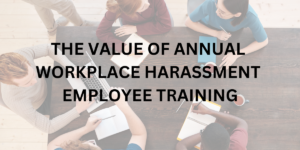
The U.S. Equal Opportunity Employment Commission (EEOC) defines sexual harassment as unwelcoming sexual advances, requests for sexual favors or other conducts that unreasonably affect the performance of a person and gives rise to a hostile, offensive, and negative working environment. Sexual harassment can take many forms such as persistently offensive jokes to inappropriate touching to physical assault, which can happen to both men and women in the workplace.
Sexual harassment allegations against media politicians and other influential people highlight the pervasive conduct of harassment in the United States. Workplace Harassment, to include sexual harassment is against federal law under the Civil Rights Act of 1964. Despite the fact that the U.S. has laws to address workplace harassment, the system is not flawless, as over 2 million people, last year, reported discrimination, retaliation, and harassment complaints to the EEOC for their hostile working environments.
As mentioned above, there are different forms of sexual harassment that take place. Some of them include:
NON-VERBAL HARASSMENT
- Staring at a person’s body.
- Facial expressions and gestures that are of a sexual nature.
- Following a person to annoy him/her.
- Passing inappropriate emails, texts or other correspondences that are of a sexual or offensive manner.
- Invading a person’s personal space.
VERBAL HARASSMENT
- Asking for sexual relationships and favors.
- Passing remarks about a person’s body, looks, clothing, age, behavior, relationships, color, class, or creed.
- Making inappropriate jokes about sex, a person’s religion, color, sexual orientation, nationality, and/or disability.
- Spreading rumors and false accusations.
- Bullying and threatening a person for refusing sexual advances.
- Discussing sexual topics.
PHYSICAL HARASSMENT
- Unwanted touching, kissing, stroking and hugging (body, hair, and clothing).
- Blocking someone’s walking path or cornering a person.
- Brushing up against another person.
- Assault.
One of the best ways to know about the prevalence of sexual harassment within the workplace is to examine the surveys conducted for employees and by the EEOC. These surveys are based on the everyday workplace events happening around the country. According to some surveys, an alarming average of 25% of people have experienced some form of “sexual harassment” while at a workplace. Many people stay quiet because of the fear of retaliation, embarrassment, inaction on their allegation, and possibly losing their jobs. Also, witnesses are unlikely to come forward and share their experience about what they observed. Approximately, 55% of witnesses stay quiet because they do not want to get involved. They too fear social or professional retaliation because they do not want to be harassed or retaliated against and they do not want to jeopardize their job.
According to multiple surveys, about 1 in 5 people in the United States have reported that they have been sexually harassed in their workplace regardless of their geographical location, their political affiliation or their income. Among men, the statistic of being sexually harassed is around 10%, which is continuing to rise. Considering age groups, 18% of people from age 18-34 state that they have been victims of sexual harassment at one point or another compared to 25% of people aged from 50-64 years old. Employees in the U.S. report that 55% of companies address workplace harassment complaints seriously and about 15% report that their company completely ignores workplace harassment.
Each year, the number of reports of employees that have been sexually harassed by their supervisors or bosses is on the rise. They also reported that those who refused sexual favors from a supervisor faced retaliation or an increase of a hostile working environment, which was in the form of denied promotions or trainings, being ostracized by colleagues or being transferred to a different or less favorable assignment. Many women chose not to speak about their sexual harassment experience because they thought it would only deteriorate their reputation and would bring them harm in their future career.
It is time that companies took responsibility and put a stop to every form of sexual harassment/workplace harassment and discrimination that exist in the U.S. workplaces. For this reason, everyone in the organization, especially the supervisors and business owners, need to take a firm stand of zero-tolerance against harassing behavior in the workplace. Top leaderships has the ability to deter such behavior. Also, preventative workplace harassment and trainings should be conducted on an annual basis with management receiving additional training. This can likely change the overall culture of sexual harassment in the workplace.
Meet the Author
Alana Williams is the CEO and Senior Investigator of J.A. Investigative Services, LLC. J.A. Investigative Services is a licensed and insured investigation agency that specializes in conducting professional and comprehensive Workplace Harassment Investigations and Workplace Harassment Prevention Training. Services and trainings are offered nationwide. Alana is a collegiate Criminal Justice Instructor and a police officer with 10 years of experience. Also, she is a Licensed Private Investigator and a Certified EEO Investigator that has conducted over 70 trainings and guest appearances with audiences of 200+. For more information about our blogs and newsletters, CONTACT US:
J.A. Investigative Services, LLC.
445 Dexter Avenue, Suite 4050
Montgomery, AL 36104
(334) 721-3970 Office
www.jainvestigativeservices.com

Read more of our articles:

